Since the successful production of humanized antibodies in the 1980s, antibody-based medications have become increasingly essential in clinical treatment, taking advantage of their low immunogenicity and long-term dosing.
So far, over 100 monoclonal antibodies (mAbs) and derived therapies have been approved for disease therapy. Key forms for these antibody-derived products include Fc fusion proteins and antibody-drug conjugates (ADCs).
These innovative antibody-based medicines preserve the targeting specificity of antibodies while also incorporating additional physiologically active components, hence increasing their therapeutic potential.
Fc fusion proteins, in particular, have shown great promise in the treatment of autoimmune diseases due to their distinct structural and functional features.
Representative drugs, including etanercept, alefacept, and abatacept, have given patients more effective treatment alternatives. The tremendous developments in antibody technology have transformed the biopharmaceutical landscape, providing new hope for patients suffering from a variety of ailments.
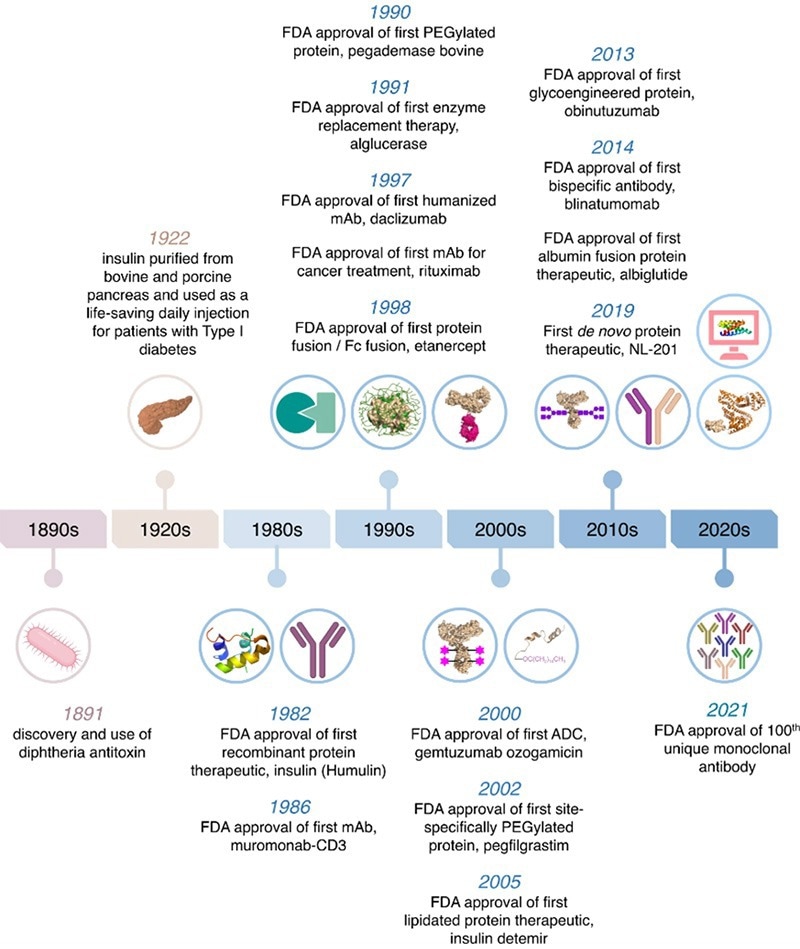
Figure 1. Milestones in protein and antibody-based drug development since 1891. As early as 1998, the biopharmaceutical landscape witnessed a groundbreaking milestone with the approval of the first Fc fusion protein drug by the US FDA – Etanercept. Etanercept, a fusion of the extracellular domain of human TNF receptor 2 (CD120) and the Fc region of human IgG1, revolutionized the treatment of autoimmune disorders such as rheumatoid arthritis. Image Credit: ACROBiosystems
According to data, the global Fc fusion protein medication market is expected to reach $30.67 billion by 2023. It is expected to rise to $62.1 billion by 2030, with a compound annual growth rate (CAGR) of 10.7 % between 2024 and 2030.
This huge increase emphasizes the enormous potential and rising relevance of Fc fusion proteins in the therapy of autoimmune disorders.
Key to antibody drug development: Half-life optimization
The half-life of Fc fusion proteins and antibody medicines is an important factor during the development process. The serum half-life of IgG1 in healthy persons is around 21 days, which is linked to the interaction between IgG and the neonatal Fc receptor (FcRn).
This interaction is critical for increasing the circulation duration of these therapeutic proteins, improving their therapeutic efficacy, and minimizing the frequency of administration.
To generate highly effective and reliable antibody-based treatments, researchers have developed a wide range of in vitro methods for detecting and characterizing FcRn-IgG interactions. These screening strategies can be generally classified into two major classes: cell-based and non-cell-based approaches.
- Cell-based detection approaches include flow cytometry, which directly examines the binding activity of cell surface-expressed FcRn and tagged IgG, providing a physiologically appropriate assessment of receptor-ligand interactions.
- Non-cell detection approaches include Surface Plasmon Resonance (SPR), Biolayer Interferometry (BLI), Homogeneous Time-resolved Fluorescence (HTRF), and AlphaLISA. These methods assess the binding properties of FcRn proteins to IgG at various pH levels, such as in solution or on fake solid surfaces.
Different detection methods have distinct benefits and drawbacks in terms of sensitivity, accuracy, reproducibility, time, and expense.
The Fluorescence Resonance Energy Transfer (FRET) theory was first postulated in 1948 and experimentally proven in 1967. This approach can detect molecular interactions within a range of 1.0-6.0 nm.
FRET technology has since become an important molecular biology detection tool due to its high sensitivity, simplicity, and broad application range, thanks to ongoing scientific research. It has been successfully used in the screening of antibody drug candidates.
New product introduction: Human FcRn Binding Kit (TR-FRET)
ACROBiosystems is excited to introduce the Human FcRn Binding Kit (TR-FRET) (Cat. No. FRT-01), which leverages Time-Resolved Fluorescence Resonance Energy Transfer (TR-FRET) technology. This kit utilizes the competitive binding mechanism of human IgG antibodies to FcRn, ensuring precise and reliable results.
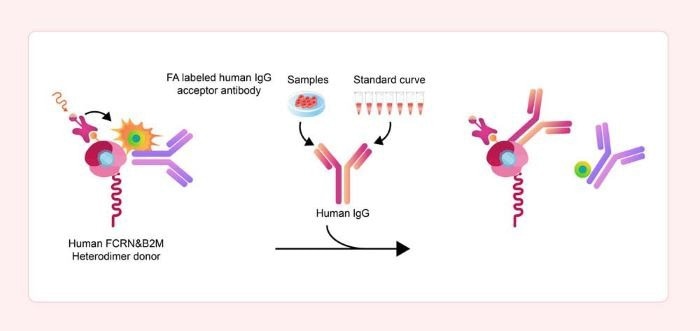
Image Credit: ACROBiosystems
Principle of the Human FcRn Binding Kit (TR-FRET)
In the Human FcRn Binding Kit (TR-FRET), the donor consists of a combination of biotinylated recombinant human FcRn and europium-chelate labeled streptavidin (SA), while the acceptor is a specific FA-labeled human IgG1 antibody.
When no other FcRn-binding components are present in the sample, the donor and acceptor molecules bind closely together. The emission spectrum of the donor partially overlaps with the excitation spectrum of the acceptor, facilitating efficient FRET.
Upon excitation at a specific wavelength, the donor emits a signal at 620 nm, which is absorbed by the acceptor, causing it to emit a signal at 665 nm. The intensity of this FRET signal is directly proportional to the formation of the FcRn-IgG complex.
Conversely, if the sample contains other components that can bind to FcRn, they will inhibit the interaction between the donor and acceptor, thereby preventing FRET. This results in a decrease in the detected signal.
Key advantages of Human FcRn Binding Kit (TR-FRET)
- "Precision and reliability": High detection sensitivity, accurate outcomes, and low matrix effects for trustworthy data.
- "Slick and streamlined": Eliminates washing processes, simplifies operations, and reduces time to get goals.
- "Unwavering consistency": Involves strict quality control of raw materials, excellent batch-to-batch uniformity, and stable supply.
Validation data of Human FcRn binding Kit (TR-FRET)
- Typical IgG antibody binding data
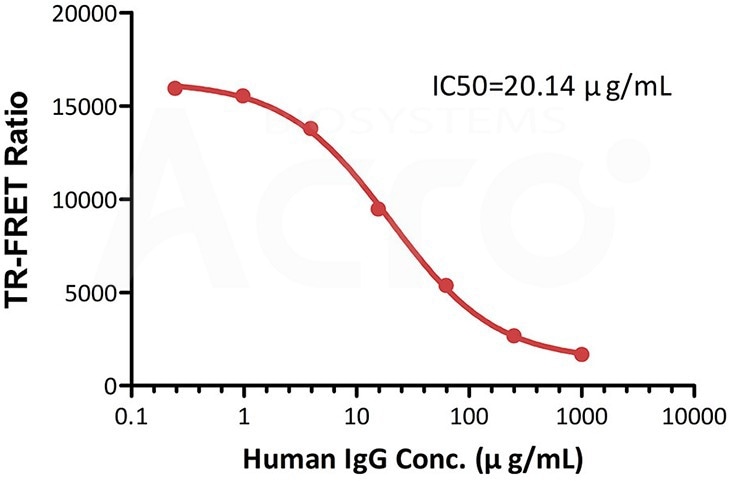
Figure 3. Premix serial dilutions of Human IgG standard (Catalog # FRT01-C03) (1:4 serial dilution, from 1000 μg/mL to 0.24 μg/mL (6666.67-1.63 nM)) and Human FCRN&B2M Heterodimer Protein Europium-chelate (Catalog # FRT01-C01) and incubate at room temperature (20℃-25℃) for 0.5 hour. Then add FA labeled human IgG antibody (Catalog # FRT01-C02) and incubate at room temperature (20℃-25℃) for 0.5 hour. Detection was performed with IC50 of 20.14 μg/mL. The assay was performed according to the above-described Datasheet (QC tested). Image Credit: ACROBiosystems
- IgG isoforms binding to FcRn
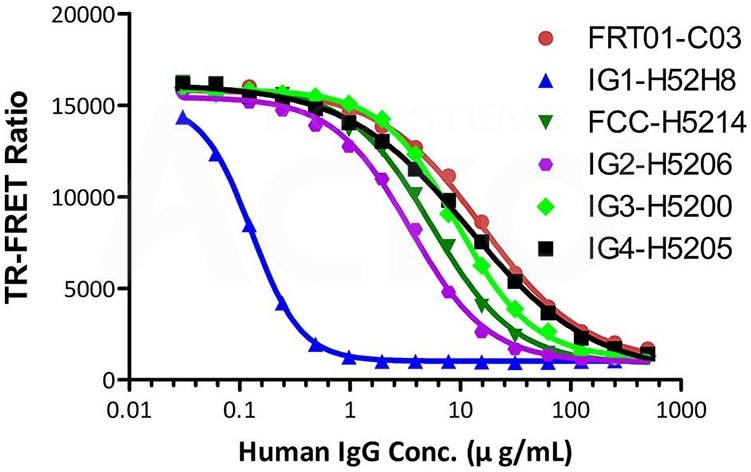
Figure 4. The kit (Cat. No. FRT-01) has been used to detect different human IgG isoforms of Human IgG1, Human IgG2, Human IgG3, Human IgG4, and modified Human IgG1 Fc (C103S, M135Y, S137T, T139E, H316K, N317F) Protein, His Tag (Cat. No. IG1-H52H8) with different affinities binding to FcRn. Image Credit: ACROBiosystems
Sparking a Powerful Synergy: The Human FcRn Binding Kit (TR-FRET) (Cat. No. FRT-01) combines high-sensitivity TR-FRET technology with high-quality ACRO FcRn proteins, making it ideal for high-throughput antibody drug screening.
References
- Liu L. Pharmacokinetics of monoclonal antibodies and Fc-fusion proteins. Protein Cell. 2018 Jan;9(1):15-32. doi: 10.1007/s13238-017-0408-4.
- Ebrahimi SB, Samanta D. Engineering protein-based therapeutics through structural and chemical design. Nat Commun. 2023 Apr 27;14(1):2411. doi: 10.1038/s41467-023-38039-x.
- Suzuki T, Ishii-Watabe A, Tada M, Kobayashi T, Kanayasu-Toyoda T, Kawanishi T, Yamaguchi T. Importance of neonatal FcR in regulating the serum half-life of therapeutic proteins containing the Fc domain of human IgG1: a comparative study of the affinity of monoclonal antibodies and Fc-fusion proteins to human neonatal FcR. J Immunol. 2010 Feb 15;184(4):1968-76. doi: 10.4049/jimmunol.0903296.
- Song Y, Deng X, Shi W, Tang F, Huang W, Gong L, Qin Q. A homogeneous time-resolved fluorometric energy transfer assay for the binding assessment of FcRn with IgG antibodies. J Immunol Methods. 2021 Dec;499:113180. doi: 10.1016/j.jim.2021.113180.
About ACROBiosystems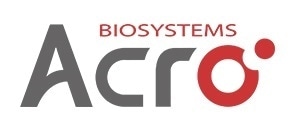
ACROBiosystems is a cornerstone enterprise of the pharmaceutical and biotechnology industries. Their mission is to help overcome challenges with innovative tools and solutions from discovery to the clinic. They supply life science tools designed to be used in discovery research and scalable to the clinical phase and beyond. By consistently adapting to new regulatory challenges and guidelines, ACROBiosystems delivers solutions, whether it comes through recombinant proteins, antibodies, assay kits, GMP-grade reagents, or custom services. ACROBiosystems empower scientists and engineers dedicated towards innovation to simplify and accelerate the development of new, better, and more affordable medicine.
Sponsored Content Policy: News-Medical.net publishes articles and related content that may be derived from sources where we have existing commercial relationships, provided such content adds value to the core editorial ethos of News-Medical.Net which is to educate and inform site visitors interested in medical research, science, medical devices and treatments.